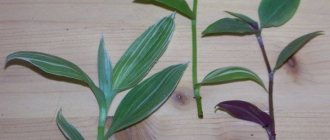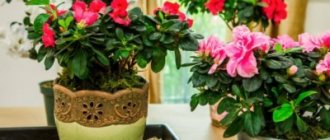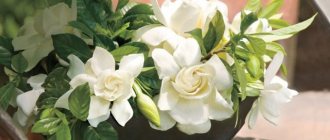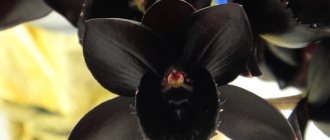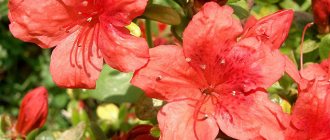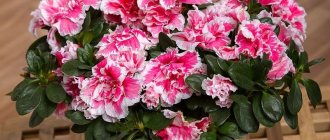The beautiful flowering perennial azalea (Azalea) is a member of the Ericaceae family. This plant is also called indoor rhododendron. Azalea is native to China, Japan and India. The name of the plant translates as “rose tree”.
Indoor azalea looks like a compact low bush, the height of which can vary from 12 to 50 centimeters. It is distinguished by strong branching. If you form the plant in the form of a standard tree, its height can exceed half a meter.
The annual growth of this slow-growing crop is several tens of millimeters. The length of the elliptical glossy leaf plates of dark green color is about 35 mm.
Spectacular flowers adorn the bush in winter and spring. Double or simple funnel-shaped flowers reach from 30 to 70 mm in diameter. As a rule, they have a single, rich color: white, purple, red or pink. There are also varieties of variegated and bicolor colors.
Landing, transplant
Many gardeners believe that it is better to buy a plant with a closed root system; such a flower will take root faster when planted. Some gardeners prefer to shake off the old lump of earth and soak the roots of the flower in a growth stimulator. Both methods of planting can be done if you take into account the general rules:
- It is better to buy a plant in specialized stores. When purchasing, inspect the plant, make sure that the leaves look healthy and are not affected by pests. The flower stem is without lesions or scratches, hard and dense. If possible, remove the plants from the pot and inspect the roots: a healthy root system is light in color.
- Having brought the flower home, put it in the bathroom for a day, let the plant adapt to the microclimate. After two days, place the flower on the windowsill, and only after 3-5 days can you start planting.
- When planting azaleas in a new pot, use specialized potting soil.
- The day before planting, water the plant with Kornevin, this will reduce stress during replanting and ensure rapid establishment of the flower in new conditions.
- It is better to plant the plant before or after flowering; if you plant a flowering rhododendron, there is a possibility of buds dropping.
- The container for planting azaleas should be 2-3 cm larger than the diameter of the earthen ball. You can’t plant a plant right away in a huge pot, this will lead to a stressful state and the flower will start to hurt. Fill with soil, water and leave for a day. Planting (transplantation) is carried out only the next day.
- When planting (transplanting, or transshipping) azaleas, make sure that there are no voids left around the roots of the plant. Press the soil onto the roots with care so as not to damage the fragile roots. After planting, water.
- After planting, it is better to place the plant in a cool, shady place. After 5-7 days, the flowerpot with azalea can be placed on the windowsill.
Home care
Do not believe those who say that caring for an indoor azalea will not cause you any trouble. This exotic beauty is absolutely unpretentious in the gardens of Japan and India, but at home you will have to tinker with it. For most azalea fans, the bush dies within a week after it appears in the house.
This is what she is - an azalea. To extend the life of fragile plants, home care after purchase consists of:
- creating optimal temperature conditions;
- moderate watering;
- good lighting.
It is better to buy an azalea when it already has several unopened buds. In its blooming form, it has a more stable immune system and adapts more easily to new conditions. Be sure to inspect the bottom of the bush. The presence of dry leaves indicates an unhealthy state of the plant. It may have been poorly cared for in the store.
Check the azalea leaves carefully for signs of insect life. When you buy an infected plant, you risk not only losing it, but also introducing diseases and pests to other indoor flowers.
The soil
To grow in a pot, you need to choose the right soil. Stores sell a special soil mixture with “Azalea Mix” written on the bag. The purchased soil is suitable for growing crops. Its pH level is around 4-5. You can independently prepare the soil for exotics by combining in equal parts:
- leaf soil;
- coniferous land;
- peat;
- sand.
Expanded clay drainage is placed at the bottom of the pot. Azaleas have roots that are very sensitive to waterlogging. If there is excess moisture, it rots. The first sign of root rot is the loss of leaves.
Lighting
Rosalia has a negative attitude towards the scorching rays of the sun. The place where the indoor flower will grow should be well lit, but the midday sun should not reach the crown. East or west windows are more suitable for azaleas. During the formation of buds, you can illuminate the bush with fluorescent lamps.
Temperature
The most important nuance, because of which most gardeners refuse this exotic acquisition. It is difficult to maintain the optimal temperature regime for this capricious beauty in an apartment. Azalea feels good at +15-+18 degrees. In order for buds to begin to form, the bar on the thermometer must drop and remain at +12 and no more.
If there is enough space between the window frames, then this will be the best place to place azaleas. The plant also feels good on a glassed, insulated loggia.
In a heated apartment, where a comfortable temperature for humans is maintained at +22 degrees, the azalea will not look beautiful and will not even bloom.
Humidity
When purchasing an azalea, stock up on a humidifier. If there is no such device, you will have to take measures to help increase the humidity in the room:
- place a jar or other vessel with water next to the pot;
- if there is an open aquarium in the house, then the azalea will grow well next to it;
- Growing azaleas requires regular spraying of the leaves, but water should not get on the petals.
When the azalea flower blooms, you need to spray it with caution, covering the buds with your palm. Spraying liquid around the area where the rosalia grows will help increase humidity. This needs to be done twice a day.
Watering
This is an important point in flower care. The question is not even how many times a week to moisten the soil, but how to water the azalea at home. The plant does not tolerate complete drying out of the earthen coma; the soil must be constantly moist. But excess moisture leads to rotting of the azalea roots.
You need to water the plant often, but little by little. The water should be settled, soft, and at room temperature. If hard water comes out of the tap, you can drop a few drops of lemon juice into a container where it settles. Experienced gardeners recommend bottom watering. That is, the pot is placed in a shallow container of water for 20-30 minutes, and then returned to its tray. The soil will be well saturated, and excess moisture will drain away.
Pinching and trimming
Caring for azaleas at home involves forming the crown of the plant. To do this, trimming and pinching are carried out. First of all, pay attention to the young shoots. They need to be trimmed so that no more than 4-5 leaves remain on each. After some time, buds will form on the azalea branches.
If you do not prune, the plant will increase its green mass and will not have the strength left for budding.
It is useful to remove all single, non-branching shoots. They spoil the aesthetic appearance of the azalea bush. Carefully inspect all the shoots remaining after pruning and pinch out those that have buds. The pinching should be done about a centimeter above the kidney. This way the indoor azalea will be evenly covered with beautiful, lush buds during flowering.
Transfer
Proper planting and care are important to grow a beautiful azalea, but it is equally important to know how to replant a flower crop without damaging the delicate root system.
After purchasing, a blooming exotic acquisition should not be transplanted immediately into another pot. It is better to replant when the bush has completely faded. This is done by transshipment while preserving the earthen clod.
The pot is chosen to be small in diameter and shallow.
In a pot that is too spacious, the azalea will direct all its efforts to developing the root system rather than flowering.
Adult plants are replanted no more than once every three years.
Feeding and fertilizer
All flowering plants need to be fed with complex mineral fertilizers. The easiest way is to buy a special composition in the form of liquid or soluble powder at a flower shop. Usually it says “For azalea” on the package. The plant is watered with this fertilizer from May to October once every two weeks.
Don't know what to feed your azalea during flowering? Choose formulations with a low nitrogen content or its complete absence; phosphorus and potassium should be in the first positions in the composition of useful substances. The most common means that gardeners use to feed azaleas are “Kemira-Lux”, “Uniflor-Bud”.
Bloom
It is impossible to make an exotic beauty bloom without lowering the temperature in the room where it grows.
Important requirements for azalea mix to please with lush buds:
- find the optimal place away from heating devices and do not move the pot;
- stop spraying - the flowers get sick from moisture and fall off;
- make sure that the earthen ball is always moist;
- increase the humidity temperature in the room;
- watering daily, when the azalea blooms, it constantly needs moisture;
- apply snow “compresses” - spread a thin layer of snow on the ground to cool the soil and roots.
Treat the question of how to care for azaleas after flowering no less responsibly. Reduce the number of waterings, trim weak shoots, remove dry leaves and twigs.
Reproduction
The methods of propagation and rooting are different. Professionals in greenhouses grow crops from seeds. For indoor floriculture, this method is too complex and time-consuming. Azaleas are propagated by cuttings and dividing the bush.
Cuttings
Choose only mature, woody shoots. When the azalea has completely bloomed, cut cuttings 10-15 cm long. Root them in acidic soil, after soaking them in a root formation stimulator. Be sure to organize a “greenhouse” from a glass jar. If everything is done correctly, the conditions for ventilation and soil moisture are met, after 3-5 weeks young leaves will appear - a sign that the plant has taken root.
Dividing the bush
This method cannot always be implemented successfully. The azalea's weak root system and very tangled thin roots do not allow dividing the bush without damaging the roots. Divide with a sharp knife, as in the photo. Each new bush needs to be transplanted into a separate pot.
Only mature bushes, aged 3-4 years, propagate.
Rest period
After flowering, the exotic goes through a dormant period for two months. Azalea does not need to be sprayed, watered regularly - it is enough to keep the earthen ball slightly moist. No fertilization or pruning required.
Diseases and pests of azaleas
It is also difficult to care for rosalia because at the slightest mistake by the grower, the bush becomes infected with fungal and putrefactive diseases. Azalea Mix is easily susceptible to late blight if moisture stagnates in the soil. As a rule, it is not possible to get rid of it even with the help of insecticides.
The indoor azalea dies very quickly and is exposed to attacks by harmful insects. Spider mites, thrips, azalea moths, and mealybugs often live inside the bush.
If the infection is not severe, you must first spray the crown with a soap solution, and when it dries, treat it with an insecticide.
Trimming and pinching
One of the important stages in the development of azaleas is timely pruning and pinching. This gives the bush a beautiful shape and stimulates flowering. The pruning procedure is carried out using sharp pruning shears or scissors wiped with disinfectants. Trim the plant after flowering has ended. The crown of indoor azaleas is formed in the shape of a ball: elongated, crooked or dried shoots are cut off. To prevent the shoots from intertwining inside the crown and interfering with ventilation, cut out the branches growing inside the bush.
To speed up the development of side shoots, pinch the tops of the stems with your hands to 8-10 cm. This procedure will force the plant to form side shoots on which flower buds are formed. After 2-3 weeks they will appear from the leaf axils, the plant will begin to form a beautiful, lush crown.
Types of azalea
Only two types of azaleas are cultivated indoors, which will be discussed in more detail below.
Japanese azalea (Azalea japonica)
This dwarf plant reaches a height of 0.3 to 0.5 m. The branches are decorated with small leathery leaf plates of a rich green color. The funnel-shaped flowers reach about 30 mm in diameter. They can be painted white or red. There are bicolor varieties.
Indian azalea (Azalea indica)
The bush reaches a height of about half a meter. Its small dark green leaf blades are oval in shape. There are very small bristles on the surface of the shoots. During flowering, inflorescences are formed, consisting of funnel-shaped flowers, which reach about 35 mm in diameter. Flowers can be painted in a variety of shades (directly depends on the variety).
Azalea - what kind of indoor flower is it, what family does it belong to?
Azaleas are flowers belonging to the Rhododendron genus. Some time ago, a separate genus of azaleas was identified - Azalea, which belongs to the Heather family. Now this genus has been disbanded, all species belonging to it have officially passed to Rhododendrons. This transition is not accidental, since Ericaceae are exclusively herbaceous plants, and Azalea has a clearly defined trunk, from which many stems extend. Tree-like Rhododendrons are perfect.
indoor azalea
Brief description, history of origin or selection
The azalea is native to Japan, China and India; it also lives in North America and southern Europe. This is a dwarf evergreen plant characterized by incredibly beautiful flowering. Rhododendron translated from Greek means “rose tree”. The name Azalea translates as “dry”. This is due to its appearance - a small, dry bush. In Russia, the flower appeared only at the beginning of the twentieth century. Initially it was grown in greenhouses and winter gardens.
Botanical description of azalea:
- In nature it grows up to 1.5 m; there are also low-growing species - about 50 cm.
- The dark green leaves are glossy on top.
- The color of double or simple flowers varies - from white to deep purple.
- Abundant flowering occurs in late autumn and continues throughout the winter, often ending only in early April.
Azalea in nature
What similar plants are there?
- Daurian rhododendron - it has small leaves and branches directed upward. It can be up to 2 m in height. The flowers are funnel-shaped. They are pink-purple in color and very large.
- Canadian rhododendron is a low-growing shrub, the height of which does not exceed 1 m. It has very long leaves - up to 6 m. The flowers are pink-purple in color.
- Jasmine gardenia is a very small bush, the height of which varies from 45 to 50 cm. The leaves are dark green and the flowers are white and double. It has a very pleasant smell.
Inexperienced gardeners may confuse azaleas with other unusual plants. You can read about its similarities and differences and other colors in our material.
This flower can become the main decoration of any home, but to do this you need to know everything about the specifics of growing azaleas at home. Otherwise, you won’t be able to see the beautiful flowering of the plant.
